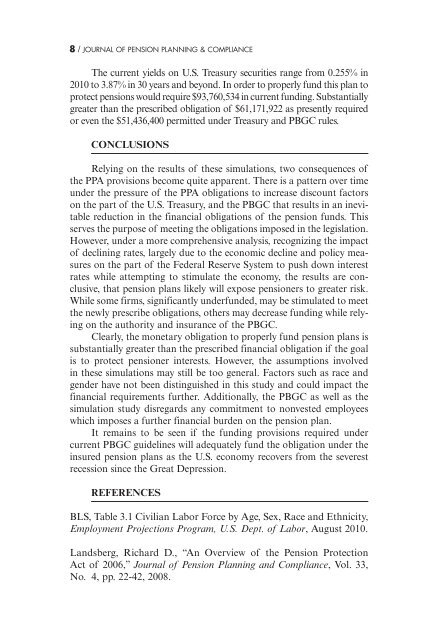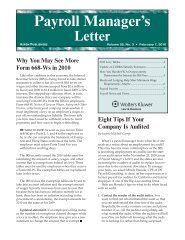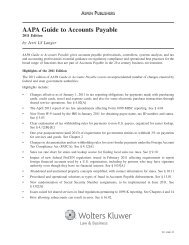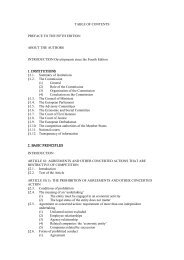journal of pension planning & compliance - Kluwer Law International
journal of pension planning & compliance - Kluwer Law International
journal of pension planning & compliance - Kluwer Law International
You also want an ePaper? Increase the reach of your titles
YUMPU automatically turns print PDFs into web optimized ePapers that Google loves.
8 / JOURNAL OF PENSION PLANNING & COMPLIANCE<br />
The current yields on U.S. Treasury securities range from 0.255% in<br />
2010 to 3.87% in 30 years and beyond. In order to properly fund this plan to<br />
protect <strong>pension</strong>s would require $93,760,534 in current funding. Substantially<br />
greater than the prescribed obligation <strong>of</strong> $61,171,922 as presently required<br />
or even the $51,436,400 permitted under Treasury and PBGC rules.<br />
CONCLUSIONS<br />
Relying on the results <strong>of</strong> these simulations, two consequences <strong>of</strong><br />
the PPA provisions become quite apparent. There is a pattern over time<br />
under the pressure <strong>of</strong> the PPA obligations to increase discount factors<br />
on the part <strong>of</strong> the U.S. Treasury, and the PBGC that results in an inevitable<br />
reduction in the financial obligations <strong>of</strong> the <strong>pension</strong> funds. This<br />
serves the purpose <strong>of</strong> meeting the obligations imposed in the legislation.<br />
However, under a more comprehensive analysis, recognizing the impact<br />
<strong>of</strong> declining rates, largely due to the economic decline and policy measures<br />
on the part <strong>of</strong> the Federal Reserve System to push down interest<br />
rates while attempting to stimulate the economy, the results are conclusive,<br />
that <strong>pension</strong> plans likely will expose <strong>pension</strong>ers to greater risk.<br />
While some firms, significantly underfunded, may be stimulated to meet<br />
the newly prescribe obligations, others may decrease funding while relying<br />
on the authority and insurance <strong>of</strong> the PBGC.<br />
Clearly, the monetary obligation to properly fund <strong>pension</strong> plans is<br />
substantially greater than the prescribed financial obligation if the goal<br />
is to protect <strong>pension</strong>er interests. However, the assumptions involved<br />
in these simulations may still be too general. Factors such as race and<br />
gender have not been distinguished in this study and could impact the<br />
financial requirements further. Additionally, the PBGC as well as the<br />
simulation study disregards any commitment to nonvested employees<br />
which imposes a further financial burden on the <strong>pension</strong> plan.<br />
It remains to be seen if the funding provisions required under<br />
current PBGC guidelines will adequately fund the obligation under the<br />
insured <strong>pension</strong> plans as the U.S. economy recovers from the severest<br />
recession since the Great Depression.<br />
REFERENCES<br />
BLS, Table 3.1 Civilian Labor Force by Age, Sex, Race and Ethnicity,<br />
Employment Projections Program, U.S. Dept. <strong>of</strong> Labor , August 2010.<br />
Landsberg, Richard D., “An Overview <strong>of</strong> the Pension Protection<br />
Act <strong>of</strong> 2006,” Journal <strong>of</strong> Pension Planning and Compliance , Vol. 33,<br />
No. 4, pp. 22-42, 2008.






